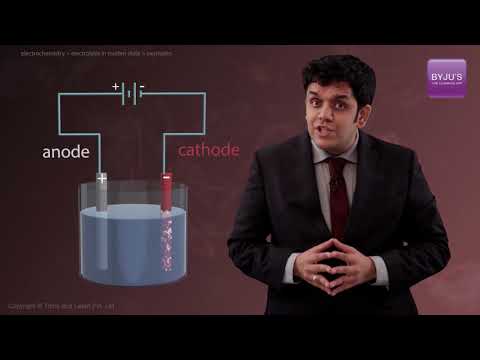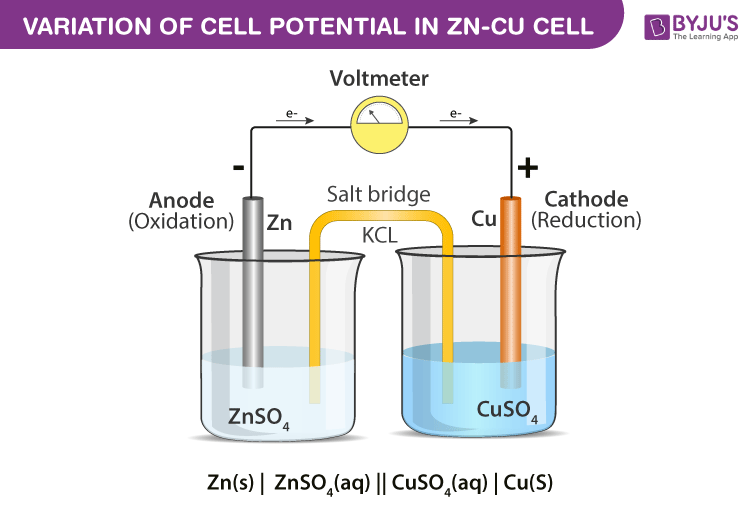What is Daniell Cell?
A Daniell cell is the best example of a galvanic cell which converts chemical energy into electrical energy.
The Daniell cell consists of two electrodes of dissimilar metals, Zn and Cu; each electrode is in contact with a solution of its own ion; Zinc sulphate and copper sulphate respectively.
Recommended Videos on Daniell Cell

Explanation of Daniell Cell in Chemistry
A typical galvanic cell, it is designed to make use of the spontaneous redox reaction between zinc and cupric ion to produce an electric current.
This cell consists of a copper vessel. In which saturated CuSO4 solution is filled which acts as depolarizer and dil.H2SO4 is filled which acts as an electrolyte. An amalgamated zinc rod is immersed in Zn2SO4. In copper vessels there is a transparent layer all around just below the upper surface in which CuSO4 crystals are kept in contact with CuSO4 solution due to this the solution always remains saturated.

Steps Involved in Daniell Cell
- The Daniell cell can be conventionally represented as
Zn(s) + Cu2+(aq) → Zn2+(aq) + Cu(s)
- In a Daniell cell electrons flow from zinc electrode to copper electrode through an external circuit, while metal ions form one half cell to the other through the salt bridge.
- Here current flows from copper electrode to zinc electrode that is cathode to anode via an external circuit.
- Daniell cell is a reversible cell while a voltaic cell may be reversible or irreversible.
Cell Reactions
Ion Zn/ZnSO4 half cell, oxidation reaction occurs.
Zn → Zn2+ + 2e–
Ion Cu/CuSO4 half cell, reduction reaction occurs.
Cu2+ + 2e– → Cu
The net cell reaction is
Zn + Cu2+ ⇌ Zn2+ + Cu
Cell is represented as
Zn/Zn2+ || Cu2+/Cu
Conditions for Voltaic Cell
- The emf of external source is more than that of voltaic cells so that current may flow from external source into the voltaic cell and cell reaction can be reversed.
- If emf of voltaic cell is more than that of external source, current flows from voltaic cell into external source
Salt bridge
It maintains electrical neutrality in two compartments by allowing movement of anions towards anodic compartment and cations towards cathodic compartment.
- It is a glass tube having potassium chloride or ammonium nitrate in a gelatin form.
- The gelatin allows ionic movement but prevents any kind of mixing.
- In the case of potassium chloride or ammonium nitrate the ionic mobilities of cations and anions are the same.
Functions of Salt bridge
- A salt bridge acts as an electrical contact between the two half cells.
- It prevents mechanical flow of solution, but it provides a free path for the migration of ions, to maintain an electric current through the electrolyte solution. It prevents the accumulation of charges.
- A salt bridge helps in maintaining the charge balance in the two half cells.
- A salt bridge minimizes or eliminates the liquid junction potential.
Frequently Asked Questions on Daniell Cell
What is Daniell cell used for?
The Daniell cell can be used to ‘generate’ electricity, or to store electricity by consuming an electrode.
What is unique about a Daniell cell?
It is known as cell Daniell. Daniell’s clever design separated the copper and zinc ions from each other which prevented polarization from interrupting the electricity flow, while at the same time allowing ions in the electrolyte to pass between the two metals, required to complete the electrical circuit.
How does Daniell cell work?
Redox reaction is the theory behind the Daniell cell. During the reaction cycle, electrons can be transferred as useful electrical current from the corroding zinc to the copper through an electrically conducting direction. The theory employed in the battery & Volta battery of daniell is the same.
What is the main function of a salt bridge?
The main function of a salt bridge is to maintain electrical neutrality in the cell and minimize liquid junction potential.
Why is cathode positive in the Daniell cell?
Since metal ions are removed from the anode as oxidation occurs, this results in accumulation of electrons on the anode which makes it negative. At cathode because there is removal of metal ions from electrolyte, electrons from cathode are used up and therefore cathode is fairly positive.

This explanation is very good and understandable. Thanks for Byjus